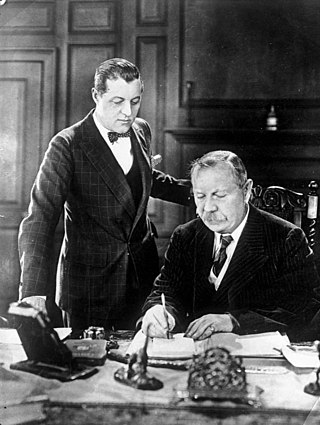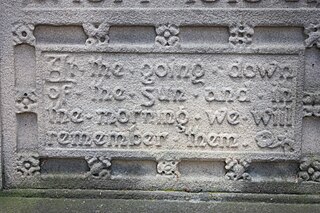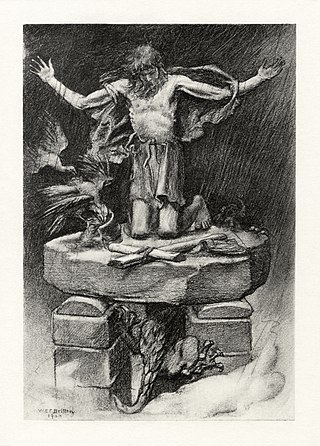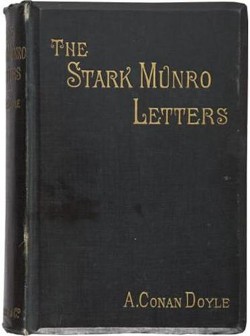Related Research Articles

Adrian Malcolm Conan Doyle was the youngest son of Sir Arthur Conan Doyle and his second wife Jean, Lady Doyle or Lady Conan Doyle. He had two siblings, sister Jean Conan Doyle and brother Denis, as well as two half-siblings, sister Mary and brother Kingsley.

George Edward Challenger is a fictional character in a series of fantasy and science fiction stories by Sir Arthur Conan Doyle. Unlike Conan Doyle's self-controlled, analytical character, Sherlock Holmes, Professor Challenger is an aggressive, hot-tempered, dominating figure.

The poem "In Memoriam A.H.H." (1850) by Alfred, Lord Tennyson, is an elegy for his Cambridge friend Arthur Henry Hallam, who died of cerebral haemorrhage at the age of twenty-two years, in Vienna in 1833. As a sustained exercise in tetrametric lyrical verse, Tennyson's poetical reflections extend beyond the meaning of the death of Hallam, thus, “In Memoriam” also explores the random cruelty of Nature seen from the conflicting perspectives of materialist science and declining Christian faith in the Victorian Era (1837–1901), the poem thus is an elegy, a requiem, and a dirge for a friend, a time, and a place.

The Lost World is a science fiction novel by British writer Sir Arthur Conan Doyle, published by Hodder & Stoughton in 1912, concerning an expedition to a plateau in the Amazon basin of South America where prehistoric animals still survive. It was originally published serially in the Strand Magazine and illustrated by New-Zealand-born artist Harry Rountree during the months of April–November 1912. The character of Professor Challenger was introduced in this book. The novel also describes a war between indigenous people and a vicious tribe of ape-like creatures.

Martin Booth was an English novelist and poet. He also worked as a teacher and screenwriter, and was the founder of the Sceptre Press.

The Poison Belt is a science fiction novel by British writer Arthur Conan Doyle, the second book about Professor Challenger. Written in 1913, much of it takes place in a single room in Challenger's house in Sussex. This would be the last story written about Challenger until the 1920s, by which time Doyle's spiritualist beliefs had begun to influence his writing.

Baker Street is a 1965 musical with a book by Jerome Coopersmith and music and lyrics by Marian Grudeff and Raymond Jessel, based on the tales of Sherlock Holmes.
"The Swimmer" is a poem by the Australian poet Adam Lindsay Gordon. The poem is from his last volume of poems Bush Ballads and Galloping Rhymes published in 1870, when he was living at Melbourne. In The Poems of Adam Lindsay Gordon, it is grouped among "Poems Swinburnian in Form and Pessimism, but full of the Personality of Gordon."

"For the Fallen" is a poem written by Laurence Binyon. It was first published in The Times in September 1914.

Micah Clarke is a historical adventure novel by British author Arthur Conan Doyle, published in 1889 and set during the Monmouth Rebellion of 1685 in England. The book is a bildungsroman whose protagonist, Micah Clarke, begins as a boy seeking adventure in a rather romantic and naive way, falls under the influence of an older and vastly experienced, world-weary soldier of fortune, and becomes a grown up after numerous experiences, some of them very harrowing. At the conclusion he must go into exile as a hunted outlaw, becomes a soldier of fortune himself and is launched on lifetime military career. In the process the book also records much of the history of the Monmouth Rebellion, from the point of view of someone living in 17th century England.
"Pleading" is a poem written by Arthur L. Salmon, and set to music by the English composer Edward Elgar in 1908, as his Op.48.

Sir Arthur Ignatius Conan Doyle was a British writer and physician. He created the character Sherlock Holmes in 1887 for A Study in Scarlet, the first of four novels and fifty-six short stories about Holmes and Dr. Watson. The Sherlock Holmes stories are milestones in the field of crime fiction.

"St Simeon Stylites" is a poem written by Alfred Tennyson in 1833 and published in his 1842 collection of poetry. The poem describes the actions of St. Simeon Stylites, a Christian ascetic saint who recounts his various physical acts in hopes that he has earned his place in heaven. It captures Tennyson's feelings following the death of a close friend, Arthur Hallam, and contains feelings of self-loathing and regret. The work has ironic overtones that give it the appearance of a satirical work.
Adventures of Sherlock Holmes; or, Held for Ransom is a 1905 American silent film directed by J. Stuart Blackton for Vitagraph Studios. It was the second film based on Arthur Conan Doyle's Sherlock Holmes stories, following the 1900 Mutoscope trick film Sherlock Holmes Baffled, and is usually regarded as the first attempt to film a "serious" Holmes adaptation. The scenario was by Theodore Liebler based on elements of Conan Doyle's 1890 novel The Sign of the Four.

Undershaw is a former residence of the author Sir Arthur Conan Doyle, the creator of Sherlock Holmes. The house was built for Doyle at his order to accommodate his wife's health requirements, and is where he lived with his family from 1897 to 1907. Undershaw is where Doyle wrote many of his works, including The Hound of the Baskervilles.

The Narrative of John Smith (2011) is a novel written in 1883 by Arthur Conan Doyle, published posthumously by The British Library. In a work of narrative fiction, Doyle writes from the perspective of a middle-aged bachelor named John Smith recovering from rheumatic gout. Unlike his later work in detective fiction, fantasy, and science fiction, this novel unfolds through a series of tangential, essay-like thoughts stemming from observations on everyday life. The subjects are of a “personal-social-political complexion”.

The Stark Munro Letters is a novel by British author Sir Arthur Conan Doyle first published in 1895 by Longmans, Green & Co. in London, England.
Daniel Stashower is an American author and editor of mystery fiction and historical nonfiction. He lives in Maryland.

George Wylie Hutchinson (1852–1942) was a painter and leading illustrator in Britain and was from Great Village, Nova Scotia, Canada. He illustrated the works of Arthur Conan Doyle, Rudyard Kipling, Hall Caine, Robert Louis Stevenson and Israel Zangwill. His paintings inspired the poem "Large Bad Picture" and "Poem", both by Elizabeth Bishop, his great grand niece. Hutchinson was a contributor to and subject of the novel The Master (1895) by Israel Zangwill, with whom he was a close friend.
"The Field Bazaar" is a short story by Arthur Conan Doyle, first published on November 20, 1896 in a special "Bazaar Number" of The Student, a publication of the students' representative council at Edinburgh University. It is a Sherlock Holmes story, published under Conan Doyle's byline and featuring both Holmes and his partner, Dr. John Watson. It is, however, treated by most experts as a parody or pastiche not suitable for inclusion in the traditional 60-story canon of Sherlock Holmes, though there are dissenters.
References
- ↑ Arthur Conan Doyle, Songs of Action (1898), pp. 116-20.
- ↑ Daniel Stashower, Teller of Tales: The Life of Arthur Conan Doyle (1999), p. 210.
- ↑ Christopher Roden, Introduction to The Memoirs of Sherlock Holmes (Oxford U. Press 1993), p. xvii.
- ↑ Arthur Conan Doyle, Memories and Adventures (1924), ch. 10.
- ↑ Stashower, p. 210.
- ↑ Martin Booth, The Doctor and the Detective—A Biography of Sir Arthur Conan Doyle (1997), p. 222.
- ↑ Stashower, pp. 210-11; see also Booth, pp. 222-23.
- ↑ Booth, p. 223.